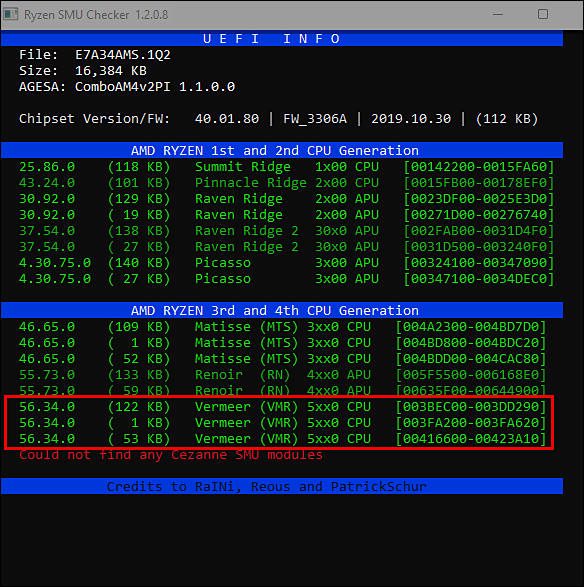
-
Follows0Replies1Views1.5KCapitalism: AMD allowed to add Ryzen 5xxx support to B350 and X370 chipsets
-
MSI released a new Windows 11 ready BIOS for its AMD 300-series motherboards though the BIOS packed one big change aside from support for the new OS. It also secretly carries support for AMD Ryzen 5000 Desktop CPUs codenamed 'Vermeer'. This can be confirmed within the Ryzen SMU Checker which is provided below and clearly lists the AMD Ryzen 5000 'Vermeer' line of chips.

For long time this guys told that old chipset can't work with new CPUs, all this time they lied, just to get more profits.
1 comment 2 comments Vitaliy_KiselevDecember 2021Last reply - January 2022 by Vitaliy_Kiselev Subscribe to this blog
Subscribe to this blog
-
-
Follows0Replies0Views605
-
Follows0Replies1Views1.9KGood quote: On happiness
-
Life is simple: Your happiness will be based completely on luck and genetics. Everything comes down to luck and genetics. And when you think about it, even your genetics is luck.
G. Carlin
1 comment 2 comments Vitaliy_KiselevDecember 2021Last reply - December 2021 by stoney Subscribe to this blog
Subscribe to this blog
-
-
Follows0Replies0Views510
-
Follows0Replies0Views512UK: Cutting food consumption
-
Energy crisis caused 500,000 Britons to cut back on food to pay bills as fuel poverty worsens.
-
-
Follows0Replies0Views533Humour: Audiophile SSD to edit your next masterpiece on
-

The device was reportedly built from the ground up in close collaboration with one of the SSD controller manufacturers. In the photo, you can see the Realtek logo - and in fact, the company known for its audio chips entered the SSD controller market a few years ago. The drive has 1TB of flash memory on board, although the usable capacity is only 333GB - it operates in pseudo-SLC (pSLC) mode, in which usable capacity is sacrificed for performance and durability. There is already an SSD on the market with support for pSLC mode, but, perhaps for the first time, it was announced that this mode improves sound quality.
In TLC mode, music sounds like a background, there are no nuances and power, everything is flat, there is not enough space and density. The pSLC mode gives rise to a special natural feeling, it [the sound] becomes smoother and more calm, the density is slightly increased, in general it is more stable when listening, but still somewhat dry.
The drive is equipped with a Crystek CCHD-957 Femto clock generator, two Audionote Kaisei 220uF capacitors, an external 5V power input, a copper radiator and gold-plated connectors. The manufacturer claims that supplying power not from the motherboard, but from an external source also has a positive effect on the sound quality.

-
-
Follows0Replies1Views893Idiots: New cloud infrastructure of Russian traffic police is offline for two days
-
The traffic police was forced to postpone the issuance of driver's licenses and registration of cars again due to a technical failure that occurred in the operation of the information system of the service on December 18. This was reported on the official website of the inspection.
As specified in the traffic police, at present, experts continue to work on eliminating the consequences of the failure, but this will take them more time than expected.
“This makes it impossible to receive citizens on December 19 in the registration and examination departments of the State Traffic Inspectorate. The approximate time of completion of the work is the evening of December 19, ”the department noted.
They added that in connection with this situation, all registration and examination departments of the traffic police will work on December 20.
Infrastructure had been extremely centralized and moved into modern cloud infrastructure recently.
1 comment 2 comments Vitaliy_KiselevDecember 2021Last reply - December 2021 by Vitaliy_Kiselev Subscribe to this blog
Subscribe to this blog
-
-
Follows0Replies0Views476Energy: Coal and evolution
-
Coal is nothing more than the energy of the Sun, which fell on the planet more than 300 million years ago. Transformed by the distant ancestors of modern spruces and birches into organic matter in the process of photosynthesis, buried under a layer of rocks, converted into almost pure carbon, she patiently waited for her hour. Carbon dioxide produced by burning coal is the same gas that plants absorbed more than 300 million years ago, converting it into organic matter.
Most of the coal deposits on the planet date back to a fairly narrow geological period. It is called so - coal, and it covers the period from 360 to 300 million years ago. There was something special at that time, something like that, why we hardly find coal beds outside this period. To understand the reasons for this phenomenon, it is necessary to study the mechanism of coal formation. Understand what specific substances play a role in this process, and what conditions they need to create. Of course, the most important molecule in this story is lignin.
Lignin is inherently not a simple molecule; it is a very complex, branched polymer with an extremely irregular structure.
Different monomers in lignin are randomly linked to other monomers, resulting in a giant, branched and very strong structure.
An important feature of lignin is that it is inedible. It is because of the very complex, irregular structure of the molecule that the chances of digesting it are extremely small. Enzymes, which usually specialize in breaking the same type of bonds of relatively simple molecules, simply cannot cope with such a cumbersome and irregular structure.
For the first time in the evolutionary history of plants, lignin appears at the end of the Devonian period, and it was at this time that the formation of the first coal beds can be observed. Later, in the Carboniferous period, plants appear on the planet that synthesize this biopolymer on a truly industrial, planetary scale, inaccessible to the modern biosphere, not to mention man.
Interestingly, the ratio of the mass of the bark, consisting of almost pure lignin, to the mass of wood in dry land plants of that time could be from 8: 1 to 20: 1, which is insanely large compared to the modern one, no more than 1: 4.
In the late Devonian period, the plant kingdom invented lignin. This allowed plants to become full-fledged masters of land, rise above the surface of the earth, break away in an evolutionary race from their competitors and defend themselves from enemies. The side effect was that the plants simply stopped decaying. Not a single living organism on the planet, as it turned out, could digest lignin, could not use it as an energy source. And this is an extremely unusual situation.
There are not many living organisms capable of "digesting" the lignin molecule today. These are mainly mushrooms. We can see them in the forest on the trunks of trees, slowly but surely transforming their obsolete plant into dust and humus. This is the so-called "white mold", which is one of the main "destroyers" of lignin in our wooden dwellings. In the Carboniferous period, there was no white mold.
This is too complex and irregular a molecule to be "hacked" and broken down into its constituents available for energy extraction.
Perhaps it was this fact, and not at all the peculiarities of the climate, that played a decisive role in providing people with fossil fuels. Today, any dead tree turns into dust very quickly, and at that time it could not physically decompose. Imagine for a moment. The planet, for tens of millions of years immersed in a multi-meter layer of non-decomposable biological waste, accumulating every year, sinking deeper under the pressure of the upper layers.
This hypothesis, put forward quite a long time ago on the basis of a number of geological findings, finds today more clear confirmation at the genetic level. The researchers compared the genomes of 31 types of fungi that can digest lignin. We found in them the regions responsible for the synthesis of enzymes that destroy lignin, and traced the evolution of these regions back in time, to the first common ancestor who received such an ability. The time was dated using the technique of the so-called "molecular clock".
The methodology is based on the scientifically justified assumption that, despite the randomness of mutations, there is a certain average frequency with which they are observed. Estimating the difference in the genome of related and not so species and knowing the frequency of mutations, it is possible to establish the approximate date of their divergence along different branches of the evolutionary tree. Applying this technique to mushrooms, it was found that the mushroom's acquisition of the ability to digest lignin dates back, no more, no less, to the end of the Carboniferous period. About 300 million years ago, the first living organisms finally saw through the protection invented by plants.
Lignin finally became the same food as any other organic matter. Plants are vulnerable again. Not only dead wood, living plants also became food for mushrooms and were forced to evolve further, coming up with new ways to protect themselves from new enemies.
Interesting.
-
Howdy, Stranger!
It looks like you're new here. If you want to get involved, click one of these buttons!
Categories
- Topics List23,911
- Blog5,718
- General and News1,330
- Hacks and Patches1,148
- ↳ Top Settings33
- ↳ Beginners254
- ↳ Archives402
- ↳ Hacks News and Development56
- Cameras2,342
- ↳ Panasonic984
- ↳ Canon118
- ↳ Sony154
- ↳ Nikon95
- ↳ Pentax and Samsung70
- ↳ Olympus and Fujifilm98
- ↳ Compacts and Camcorders295
- ↳ Smartphones for video96
- ↳ Pro Video Cameras191
- ↳ BlackMagic and other raw cameras116
- Skill1,959
- ↳ Business and distribution66
- ↳ Preparation, scripts and legal38
- ↳ Art149
- ↳ Import, Convert, Exporting291
- ↳ Editors190
- ↳ Effects and stunts115
- ↳ Color grading197
- ↳ Sound and Music280
- ↳ Lighting96
- ↳ Software and storage tips266
- Gear5,407
- ↳ Filters, Adapters, Matte boxes344
- ↳ Lenses1,577
- ↳ Follow focus and gears93
- ↳ Sound496
- ↳ Lighting gear313
- ↳ Camera movement230
- ↳ Gimbals and copters302
- ↳ Rigs and related stuff271
- ↳ Power solutions83
- ↳ Monitors and viewfinders339
- ↳ Tripods and fluid heads139
- ↳ Storage286
- ↳ Computers and studio gear559
- ↳ VR and 3D248
- Showcase1,859
- Marketplace2,834
- Offtopic1,314





